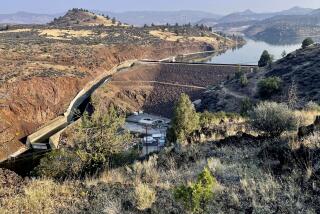No Past Present : Archeologists at Development Site Come Up Empty in Search for Indian Village
- Share via
As McCoy Pyle was hunting for deer on his Santa Clarita farm one day 108 years ago, he happened upon one of the largest troves of Indian artifacts ever found in the United States.
But when a team of archeologists armed with backhoes and maps dug up another part of the Pyle farm Friday, they discovered nothing but a few ordinary rocks and a broken bullet casing.
The results of the excavation dashed the hopes of historians of the Santa Clarita Valley, but pleased the developer who plans to build an industrial center on the property. If the archeologists find nothing of historic value by this afternoon on the land, located near California 126 about 1.3 miles west of the Golden State Freeway, the excavation will end and the process involving the construction of the Valencia Commerce Center, which began in June with the grading of an access road, will proceed.
The archeologists are searching for signs of Tsavangu, an Indian village built by the Tataviam tribe about 450 AD, said Jerry Reynolds, curator of the Santa Clarita Historical Society and a consultant hired to oversee the excavation. The Indians were attracted by the site’s natural freshwater spring, he said.
Tsavangu was abandoned in 1804 when its residents moved to Santa Clarita, the fledgling Spanish mission located nearby. The land on which the village stood was seized by the Mexican government in 1821, sold to a Mexican army official in 1839 and occupied by the Pyle family under squatting rights in 1882, Reynolds said.
“It would have been really exciting if they would have actually been able to verify that that Indian village was indeed there,” Reynolds said.
McCoy Pyle made his monumental discovery of artifacts in 1882 in a cave four miles west of his family’s farm, Reynolds said. Steven Bowers, who was a local newspaper editor and owner of the property on which the cave sat, bought the cache of artifacts for $1,500 in 1884 and sold it to Harvard University’s Peabody Museum in 1885, the Santa Clarita historian said.
The land is now owned by the Newhall Land and Farming Co., the developer that built the Santa Clarita Valley community of Valencia in 1965 and hopes to finish the industrial park by 2010, company spokeswoman Carol Maglione said.
During Friday’s excavation, required by law because a county map identifies the site as having potential archeological significance, two bulldozers dug trenches across the width of the former Pyle farm.
“We’ll kind of hop, skip and jump around,” said Louis Tartaglia, the archeologist directing the dig. “We don’t know through history whether it’s been mapped wrong or bulldozed.”
Each trench was between 10 feet and 16 feet deep and was about 20 feet long. The trenches formed two parallel dotted lines across the field, the lines about 25 feet apart and each trench about 55 feet from the one next to it.
As the backhoes dug deeper, two archeologists working with Tartaglia examined the soil and the walls of the trenches for signs of artifacts. When the archeologists were satisfied that the dirt contained nothing of historic value, the backhoe operators filled the trenches and advanced to another site on the field.
Tartaglia will use the excavation results, which he recorded in a spiral notebook, to analyze whether there is any archeological reason not to develop the land. If nothing of historic importance is found on the site, Tartaglia will finish the report within a few months, Maglione said.
The digging of trenches normally is an intermediate step in the excavation of an area believed to contain artifacts, said Bruce Love, a UCLA archeologist who specializes in archeology of the Antelope Valley.
The first step simply involves examining the surface of the ground to check soil color and rock shapes and to look for unburied bits of artifacts, he said. If the ground appears likely to contain artifacts, trenches are dug, he said. If the trenches reveal signs of valuable artifacts, archeologists use hand tools to sift more gently through the earth, he said.
More to Read
Sign up for Essential California
The most important California stories and recommendations in your inbox every morning.
You may occasionally receive promotional content from the Los Angeles Times.













